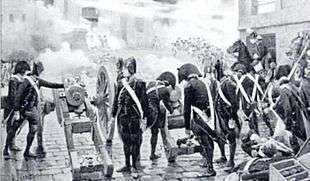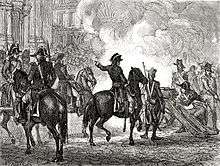13 Vendémiaire
13 Vendémiaire Year 4 in the French Republican Calendar (5 October 1795 in the Gregorian calendar) is the name given to a battle between the French Revolutionary troops and Royalist forces in the streets of Paris.
| 13 Vendémiaire | |||||||
|---|---|---|---|---|---|---|---|
| Part of the French Revolution and the War of the First Coalition | |||||||
 Napoleon Bonaparte's quelling of the Royalist revolt, 13 Vendémiaire, in front of the Église Saint-Roch, Saint-Honoré Street, Paris. | |||||||
| |||||||
| Belligerents | |||||||
|
|
| ||||||
| Commanders and leaders | |||||||
|
|
| ||||||
| Strength | |||||||
|
4,500 Regular Troops 1,500 'Patriots' Total:- 6,000 Men 40 cannons | 30,000 men | ||||||
| Casualties and losses | |||||||
| 100 dead and wounded |
300 dead 2 executed | ||||||
| 400 civilians | |||||||
This battle was part of the establishing of a new form of government, the so-called Directory, and it was a major factor in the rapid advancement of Republican General Napoleon Bonaparte's career.
Background
The social reforms of the French Revolution had been well received by the majority of the populace of France, but the Revolution's strongly anti-Catholic stance had created anti-republican sympathies in many Roman Catholics. In March 1793, this sentiment boiled over into an armed insurrection in the fiercely Catholic Vendée region of western France. A rebel army titled Armée catholique et royale now proved to be a thorn in the side of the Revolutionary Government in Paris, under leaders such as François de Charette de la Contrie and Maurice d'Elbée. The rebels were known as Chouans, a title which comes from early royalist leader Jean Cottereau's nickname Jean Chouan. He was known for his perfect imitation of an owl's cry, a noise which had become the rallying cry of the insurgents of Vendée.
The Armée catholique et royale quickly garnered British support and got off to a promising start, severely defeating several Revolutionary Armies. The Revolutionary Committee of Public Safety ordered General Jean-Baptiste Carrier to pacify the region, and over several months Carrier ruthlessly decimated the populace of the Vendée. The local population dubbed Carrier's forces the colonnes infernales (hellish columns). On 22 December 1793, the Chouan rebellion subsided following a major defeat at the Battle of Savenay.
Following the 9th Thermidor, those Chouans willing to lay down arms were granted amnesty by the reformed National Convention. The Chouans responded by attacking the Republican-held town of Guémené on 28 January 1795. The Convention immediately ordered General Hoche to proceed to the Vendée and force the Chouans to agree to a cessation of hostilities. Hoche quickly defeated the Chouan army and on 17 February François de Charette de la Contrie signed a very generous peace settlement.
A small contingent of Royalists under the command of General Stofflet and the fanatical Abbé Bernier refused to accept the peace settlement and continued to offer resistance to Hoche's Army. They were supported by the British in the form of 4,000 émigrés, 80,000 muskets, and 80 cannon, along with food, clothing, and even a large quantity of counterfeit assignats (to provide the Chouans with funding, but also to unbalance the French economy).
This large force was placed under the command of émigré Générals Puisaye and Hermilly. Hearing of this, de Charette de la Contrie broke the peace agreement and reopened hostilities. On 26 June, the émigré force landed at Carnac. Hermilly quickly advanced on Auray before engaging and being defeated by Hoche at Vannes. By early July, Hemilly had been forced out of Auray and was besieged in the Fortress of Penthièvre. This meant that the entire insurgent army was now trapped on the Quiberon peninsula. On 15 July, an additional émigré division arrived to bolster the defense, under the command of Général Sombreuil, but Hermilly was killed in action on 16 July. By the 20th, the fortress had fallen and Hoche swiftly advanced down the peninsula, defeating the hopelessly trapped émigré army. Only Général Puisaye and a small force were able to escape with the British fleet; the remainder were killed in action, taken prisoner, or executed.
Despite the failure of the émigré army, de Charette de la Contrie continued to offer resistance. In early September, a popular revolt broke out in the area around Dreux, but it was defeated in battle at Nonancourt. De Charette de la Contrie himself suffered a major defeat at Saint-Cyr on 25 September. Despite this, the Comte d'Artois landed at Île d'Yeu with 1,000 émigrés and 2,000 British troops. Bolstered by this force, the Royalist troops began marching on Paris in early October 1795. The arrival of the Comte d'Artois excited the jeunesse dorée royalist supporters in the Le Peletier section of the capital (named for the Rue Le Peletier in what is now the Second Arrondissement), and they began demonstrations in the form of felling Liberty Trees and trampling cockades of France. Rumours began to circulate regarding the likely defection of the entire Paris National Guard.
Vendémiaire

The Convention quickly realised that it was in severe danger, and that an enemy force was on French soil; indeed, the uprising in Paris meant that there was now an enemy force within the capital itself. The Convention declared its intention to remain in their meeting rooms until the crisis was resolved. It called for the formation of three battalions of patriots to be raised from the Jacobin military staff dismissed after 9 Thermidore. Général Menou was given command of the defence of the capital, but he was severely outnumbered with only 5,000 troops on hand to resist the 30,000-man Royalist Army.
On 12 vendémiaire (4 October 1795), the National Guard arrived in Le Peletier in an attempt to put down the unrest. The Military Committee of the Sections of the Capital under the command of Richer de Sévigny announced that the decrees of the Convention were no longer recognised. Général Danican took command of the National Guard in the Le Peletier section. The Convention ordered Menou to advance into Le Peletier, to disarm the entire area, and to close Danican's headquarters. Generals Despierres and Verdière were sent to Menou to assist him. Menou divided his force into three columns and planned an advance into Le Peletier on the evening of 12 vendémiaire. When the advance was set to begin, Despierres reported that he was unwell and unable to proceed, and Verdière refused to advance. Menou timidly advanced towards the Royalist force, inviting the rebels to discuss terms of their dispersal. He withdrew after receiving the insurgents' promise to disarm.
The Le Peletier section, seeing this as a sign of weakness on the part of the Convention, called upon the other sections of Paris to rise up. Menou realised his mistake, and launched a cavalry attack down the Rue du Faubourg-Montmartre, temporarily clearing the area of royalists. The Convention dismissed Menou from the command and ordered Paul Barras to take over the defence of the Convention.
A whiff of grapeshot

Young General Napoléon Bonaparte was aware of the commotion, and he arrived at the Convention around this time to find out what was happening. He was quickly ordered to join Barras' forces mustering for the defence of the Republic. Bonaparte accepted, but only on the condition that he was granted complete freedom of movement.
At 1 am on 13 Vendémiaire (5 October), Bonaparte overrode Barras, who was content to let him do as he wished. Bonaparte ordered Joachim Murat, a sous-lieutenant in the 12ème Régiment de Chasseurs à Cheval, to ride to the plain of Sablons and to return with the 40 cannons which Menou had indicated were located there. Murat's squadron retrieved the cannons before the Royalists arrived and Bonaparte organised their arrangement, placing them in commanding areas with effective fields of fire.
At 5 am, a probing attack by the royalist forces was repulsed. Five hours later, the major Royalist assault began. The Republican forces were outnumbered by approximately 6 to 1, but they held their perimeter all the same, the cannons firing grapeshot into the massed royalist forces. The "patriot battalions" supporting the artillery also cut down the advancing Royalist ranks. Bonaparte commanded throughout the two-hour engagement, and survived unscathed despite having his horse shot from under him. The effect of the grapeshot and the volleys from the patriot forces caused the Royalist attack to waver. Bonaparte ordered a counterattack led by Murat's squadron of Chasseurs. At the close of the battle, around three hundred royalists lay dead on the streets of Paris.
Scottish philosopher and historian Thomas Carlyle later famously recorded that, on this occasion, Bonaparte gave his opponent a "Whiff of Grapeshot"[1] and that "the thing we specifically call French Revolution is blown into space by it." That is, 13 Vendémiaire marks the ending of the French Revolution. (The phrase is often ascribed to Bonaparte himself, but the words are probably Carlyle's.[2])
Aftermath
The defeat of the Royalist insurrection extinguished the threat to the Convention. Bonaparte became a national hero, and was quickly promoted to Général de Division. Within five months, he was given command of the French army conducting operations in Italy. The defeated royalists, in an effort to portray the Republican defense as a massacre, nicknamed Bonaparte Général Vendémiaire, a title which he later claimed would be his first title of glory.
In film
The first episode of the 2002 miniseries Napoléon portrays the battle of 13 Vendémiaire.
Notes
- Carlyle, The French Revolution, vol.III, book 3.VII
- Napoleon's Whiff of Grapeshot. By Jonathan Gifford (undated). Accessed 2015-01-20. Archived 2015-04-09.
References
- Asprey, Robert B. – The Rise of Napoleon Bonaparte, 604 pages, ISBN 0-465-04881-1
- Chandler, David G. – Campaigns of Napoleon, 1216 pages, ISBN 0-02-523660-1
- Franceschi, M. Gen (ret.) – The 13 Vendémiaire, republican coronation of Napoleon
- Hibbert, Christopher – The Days of the French Revolution, 384 pages, ISBN 0-688-16978-3
- Lacretelle, Jean-Charles-Dominique. "Account of the 1795 Vendémiaire Uprising", Napoleon: Symbol for an Age, A Brief History with Documents, ed. Rafe Blaufarb (New York: Bedford/St. Martin's, 2008), 33–35.
External links
